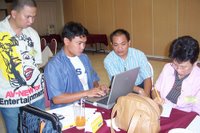9:46 AM
 NGOs in the Philippines contribute greatly to the national HIV/AIDS response however such efforts have not been documented and included to national reports. Thus, the Phase III of the M&E Project “Strengthening the Monitoring and Evaluation System of the Philippines HIV/AIDS Response” emphasizes the inclusion of NGOs and other partner agencies responding to HIV and AIDS who are not part of the formal government structure. This project strengthens the participation of NGOs, private sectors, and faith-based organizations. It also reinforces NGO-GO partnership.
NGOs in the Philippines contribute greatly to the national HIV/AIDS response however such efforts have not been documented and included to national reports. Thus, the Phase III of the M&E Project “Strengthening the Monitoring and Evaluation System of the Philippines HIV/AIDS Response” emphasizes the inclusion of NGOs and other partner agencies responding to HIV and AIDS who are not part of the formal government structure. This project strengthens the participation of NGOs, private sectors, and faith-based organizations. It also reinforces NGO-GO partnership.The second quarter of the implementation of the project continued its mapping to identify more NGOs and/or CSOs responding to HIV and AIDS. Through the mapping, we were able to identify as well which NGOs/CSOs respond to the national plan and national indicators. These NGOs/CSOs will be trained on M&E.
The M&E Sub-plan for NGOs/CSOs was presented to NGOs, PNAC Technical Working Group, and to the PNAC members at the 19th Plenary Meeting. The national M&E plan was also approved at the Plenary Meeting. Followed immediately was the pilot testing of the system. The pilot testing was initiated through the Local AIDS Councils (LACs). LACs are identified to be the primary link to establishing and strengthening M&E at the local level. Eight meetings were conducted with LACc. A dialogue with funding agencies has clarified their roles to the national M&E system.
HAIN and HDII continued to work in partnership and also the PNAC secretariat and with support from UNAIDS. A UNV (United Nations Volunteer), Prof. Morten Grimnes, was requested by the PNAC Secretariat to provide IT support in strengthening PNAC’s capacity.
During the second quarter and as the project progressed, the M&E Team made some changes in the workplan to allow geographical expansion and flexibility in pilot sites. For example, instead of 6 M&E pilot local sites, we added two more to represent geographical balance. In addition, the training for NGOs and Local AIDS Councils on M&E Data Management was supposed to be conducted separately. However, many NGOs are also members of the LACs. It was then realized that all trainings – Data Management and CRIS specifically, be held after all LAC meetings have been conducted and that non-LAC member NGOs should be merged to strengthen local partnership. -

